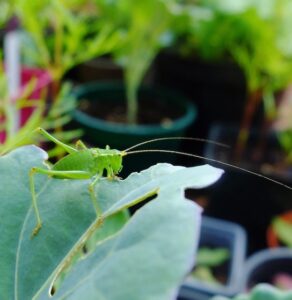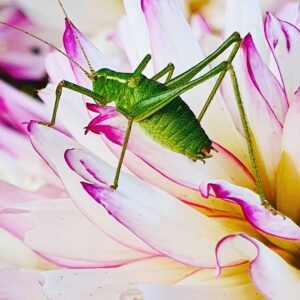Do you ever hear the chirping sound of crickets in your garden and wonder if they are causing damage to your plants? While these small insects might seem harmless, they can be quite destructive to gardens if left unchecked.
These small, chirping insects are known for their distinctive sound. They can wreak havoc on your plants and leave you scratching your head about how to control their population.
If you’re a gardener or just someone who loves spending time outdoors, it’s important to know whether crickets are garden pests and how to protect your plants from their damage.
In this article, we’ll explore the topic of crickets as garden pests, discuss their behavior and diet, and provide tips on how to identify and control cricket damage in your garden. So grab a cup of tea, sit back, and let’s dive into the world of crickets in the garden.
Are crickets garden pests?
When we talk about insects as garden pests, we typically refer to those that cause damage to plants or otherwise disrupt the garden ecosystem. So what makes an insect a garden pest?
Generally, any insect that causes significant damage to plants or interferes with their growth or reproduction can be considered a garden pest.
Crickets are no exception. While they may seem harmless and even cute, they can be quite destructive to gardens if left unchecked. So how can crickets be harmful to gardens? Here are a few ways:

- Feeding damage: Crickets are known to feed on a variety of plant materials, including leaves, stems, and fruit. They can cause significant damage to crops and ornamental plants, particularly in high numbers.
- Root damage: Some species of crickets are known to feed on plant roots, which can weaken the plant and make it more susceptible to disease or other pests.
- Seedling damage: Young plants and seedlings are particularly vulnerable to cricket damage, as they have not yet had a chance to establish strong root systems or develop defenses against pests.
- Transmitting plant diseases: Some species of crickets are known to transmit plant diseases, which can further damage your garden.
- Attracting predators: Crickets are a food source for many predators, including birds, rodents, and other insects. When crickets are present in your garden, they can attract these predators and lead to even more damage.
Plants Crickets Like
Now that we know how crickets can be harmful to gardens, let’s take a look at some examples of plants that are particularly vulnerable to cricket damage:
- Tomatoes: Crickets are known to feed on tomato plant roots, which can cause stunted growth and reduced yield.
- Cucumbers: Crickets may feed on the leaves and stems of cucumber plants, which can weaken the plant and make it more susceptible to disease.
- Beans: Crickets can cause significant damage to bean plants by feeding on the roots and leaves.
- Strawberries: Crickets may feed on strawberry plant roots, which can lead to reduced yield or even plant death.
- Peppers: Crickets may feed on the leaves and stems of pepper plants, which can cause physical damage and make the plant more susceptible to disease.
- Squash: Crickets can cause damage to squash plants by feeding on the leaves, stems, and roots.
- Eggplants: Crickets may feed on the roots of eggplant plants, which can cause stunted growth and reduced yield.
- Radishes: Crickets may feed on the leaves and stems of radish plants, which can cause physical damage and reduce the overall health of the plant.
- Lettuce: Crickets can cause damage to lettuce plants by feeding on the leaves and stems.
- Melons: Crickets may feed on the roots and leaves of melon plants, which can weaken the plant and make it more susceptible to disease.
Of course, these are just a few examples, and crickets can potentially damage a wide variety of plants in the garden. The key is to be vigilant and take steps to prevent cricket damage before it becomes a major problem.

Types of Crickets
Crickets are a diverse group of insects that belong to the order Orthoptera. There are over 900 species of crickets found worldwide, with varying sizes, shapes, colors, and habitats. In this section, we’ll take a closer look at some of the most common types of crickets found in gardens.
- Field crickets: These crickets are the most common type found in gardens and agricultural fields. They are typically brown or black and have long, thin antennae. Field crickets are known for their loud chirping, which is most often heard at night.
- Mole crickets: These crickets are named for their subterranean lifestyle and are often considered pests of turfgrass. Mole crickets have shovel-like front legs that they use to dig through soil. They are typically brown and have short, thick antennae.
- Camel crickets: Also known as cave crickets, camel crickets are found in damp environments such as caves, basements, and crawl spaces. They are characterized by their long, spindly legs and humpbacked appearance. Camel crickets do not have wings and are unable to chirp like other types of crickets.
- Tree crickets: These crickets are found in trees and shrubs and are often brightly colored with long, thin antennae. They are typically green or brown and have wings that allow them to fly.
- Snowy tree crickets: These crickets are named for their white, waxy appearance and are found in trees and shrubs. They are known for their high-pitched chirping, which is used to attract mates.
- Jerusalem crickets: These crickets are also known as potato bugs and are found in arid regions. They are large, heavy-bodied insects with a distinctive appearance that includes a round, bald head and thick legs.
While these are just a few of the many types of crickets found in the world, they are some of the most common ones that you might encounter in your garden.
- KILLS & REPELS. A preventative and a treatment, this spray is a natural pest repellent, and kills mosquitoes, ants, fleas, ticks, roaches, flies, scorpions, chiggers, crickets, chinch bugs, japanese beetles, no-see-ums, gnats and more. Safe alternative to conventional pesticide sprays, baits, ant granules, zappers or foggers.
- ATTACH & SPRAY! Just attach directly to a garden hose, spray your backyard, and enjoy. Safe around cats, dogs and people of all ages when used as directed, with no wait time for drying or reentry into sprayed outside areas. Keep the bottle & Refill the sprayer with our Outdoor Pest Control Concentrate!
- TREATS UP TO 5,000 SQUARE FEET. A bug control spray that can be safely used on lawns, gardens, grass, picnic areas, playgrounds, patios, vegetables, flowers, siding, brick, paint and more. Treat an existing pest infestation or for prevention. Application coverage depends on water pressure and walking speed.
Which types of gardens are most vulnerable?
While crickets can be found in a variety of gardens, some types may be more vulnerable to cricket damage than others. For example, vegetable gardens and ornamental gardens that feature a lot of flowering plants may be more attractive to crickets due to the abundance of food sources.
Additionally, gardens that are located near fields or other natural areas may be more likely to have cricket infestations, as crickets often travel from these areas in search of food and shelter.
However, it’s important to note that any type of garden can be vulnerable to cricket damage, regardless of the plant species grown. Crickets are known to feed on a wide variety of plants, including vegetables, fruits, flowers, and ornamental shrubs.
How to identify cricket damage in your garden
If you suspect that crickets may be present in your garden, there are several signs to look for. Here are some tips for identifying cricket damage in your garden:
- Look for feeding damage: As we mentioned earlier, crickets are known to feed on a wide variety of plants, including leaves, stems, and fruits. Look for signs of feeding damage, such as ragged or chewed edges on leaves, missing foliage, or damaged fruits. In severe cases, entire plants may be defoliated or killed.
- Check for tunnels or burrows: Some types of crickets, such as mole crickets, are known for their burrowing behavior. Look for tunnels or burrows in the soil around your plants, particularly in areas where the soil is moist or damp.
- Listen for chirping: Male crickets are known for their loud chirping, which is often used to attract mates. Listen for chirping sounds in your garden, particularly at night when the noise is more noticeable.

Differentiate cricket damage from damage caused by other pests
To differentiate cricket damage from damage caused by other pests or environmental factors, it’s important to take a close look at the type of damage present. Here are some tips for identifying the type of damage crickets can cause:
- Look for ragged or chewed edges on leaves: This type of damage is often indicative of cricket feeding, as crickets tend to chew on plant tissue in a random, ragged pattern.
- Check for missing foliage: If you notice that leaves or entire branches are missing from your plants, crickets may be the culprit. Crickets tend to feed on foliage and can quickly defoliate plants if left unchecked.
- Look for tunnels or burrows in the soil: If you notice tunnels or burrows in the soil around your plants, mole crickets may be present. Mole crickets are known for their burrowing behavior and can cause extensive damage to plant roots.
- Listen for chirping: Male crickets are known for their loud chirping, which is often used to attract mates. If you hear chirping sounds in your garden, particularly at night when the noise is more noticeable, it may be indicative of a cricket infestation.
By identifying the specific type of damage present in your garden, you can take steps to control cricket infestations and protect your plants from further damage.
It’s important to note that other pests or environmental factors can also cause damage to your garden plants. For example, caterpillars and slugs can also cause ragged edges on leaves, while drought or nutrient deficiencies can cause yellowing or wilting of foliage.
- KILLS & REPELS. A preventative and a treatment, this spray is a natural pest repellent, and kills mosquitoes, ants, fleas, ticks, roaches, flies, scorpions, chiggers, crickets, chinch bugs, japanese beetles, no-see-ums, gnats and more. Safe alternative to conventional pesticide sprays, baits, ant granules, zappers or foggers.
- ATTACH & SPRAY! Just attach directly to a garden hose, spray your backyard, and enjoy. Safe around cats, dogs and people of all ages when used as directed, with no wait time for drying or reentry into sprayed outside areas. Keep the bottle & Refill the sprayer with our Outdoor Pest Control Concentrate!
- TREATS UP TO 5,000 SQUARE FEET. A bug control spray that can be safely used on lawns, gardens, grass, picnic areas, playgrounds, patios, vegetables, flowers, siding, brick, paint and more. Treat an existing pest infestation or for prevention. Application coverage depends on water pressure and walking speed.
By closely observing the type of damage present on your plants and considering other factors such as pest behavior and environmental conditions, you can accurately identify cricket damage and take steps to control infestations.
To further confirm the presence of crickets in your garden, you can also try using sticky traps or placing a damp towel on the soil surface overnight. Crickets are attracted to moisture and may become trapped on the sticky surface or beneath the towel.
How to Control and Get Rid of Crickets in the Garden
Controlling and getting rid of crickets in the garden can be challenging, but there are several methods available to help manage infestations. Here are 10 effective ways to control and eliminate crickets in your garden:
- Remove hiding places: Crickets like to hide in dark, moist areas, so removing debris such as leaves, mulch, and grass clippings can help reduce their numbers. Additionally, sealing cracks and gaps in walls and foundations can help keep crickets from entering your home or garden.
- Use natural predators: Certain animals, such as birds, toads, and lizards, are natural predators of crickets and can help keep their populations in check. You can encourage these animals to visit your garden by providing food, water, and shelter.
- Use physical barriers: Covering your plants with netting or row covers can help prevent crickets from accessing them. This method is particularly effective for smaller gardens.
- Install sticky traps: Sticky traps, available at most garden centers, can be an effective way to catch crickets. Place traps near areas where crickets are known to hide or travel, such as near foundations or under plant foliage.
- Apply diatomaceous earth: Diatomaceous earth is a natural powder made from fossilized diatoms that can help control cricket populations. Sprinkle the powder around the perimeter of your garden or directly on plants that are being damaged.
- Use insecticidal soap: Insecticidal soap is a safe and effective way to control crickets in the garden. Spray the soap directly on plants that are being damaged or around the perimeter of your garden.
- Apply neem oil: Neem oil is a natural insecticide that can help control crickets in the garden. Mix the oil with water and spray on plants that are damaged or around the perimeter of your garden.
- Set up a bait station: Bait stations, which attract crickets with food or pheromones, can be an effective way to control their populations. Place bait stations near areas where crickets are known to hide or travel.
- Apply chemical insecticides: Chemical insecticides, while effective, should be used as a last resort due to their potential impact on beneficial insects and the environment. Follow label instructions carefully and apply only in areas where crickets are present.
- Reduce moisture levels: Crickets are attracted to moisture, so reducing watering frequency and removing sources of standing water can help discourage them from settling in your garden.
- Call a professional exterminator: If all else fails, it may be necessary to call a professional exterminator to help control cricket populations in your garden.
By using a combination of these methods, you can effectively control and eliminate crickets in your garden and protect your plants from further damage.
It’s important to note that while these methods can be effective in controlling cricket populations, they may not eliminate them. Regular monitoring and maintenance of your garden can help ensure that cricket populations remain under control.

Prevention and control of cricket infestation in gardens
Preventing cricket infestations in your garden is the best way to avoid damage to your plants and reduce the need for control methods. Here are some preventative measures you can take:
- Remove hiding places: As mentioned before, crickets like to hide in dark, moist areas. Removing debris such as leaves, mulch, and grass clippings can help reduce their numbers.
- Keep your garden clean: Regularly clean up fallen leaves, weeds, and other debris from your garden to reduce the chances of crickets finding hiding places.
- Use physical barriers: Placing physical barriers around your garden, such as fences or mesh, can help keep crickets out.
- Use companion planting: Certain plants, such as marigolds, can help repel crickets and other pests. Planting these companion plants around vulnerable plants can help deter crickets.
- Use drip irrigation: Watering your garden with a drip irrigation system instead of overhead sprinklers can reduce the moisture levels that crickets need to survive.
- Use essential oils: Some essential oils, such as peppermint and eucalyptus, can help repel crickets. Mix a few drops of the oil with water and spray around the perimeter of your garden.
By following these preventative measures, you can reduce the likelihood of cricket infestations in your garden and keep your plants healthy and thriving.
Are Crickets Garden Pests FAQs
How can I distinguish between good and bad crickets in my garden?
It can be challenging to distinguish between good and bad crickets in your garden because they all look very similar. However, the main difference is in their behavior. Good crickets, such as the field cricket, feed on insects and other small organisms that can harm your plants.
On the other hand, bad crickets, such as the mole cricket and the house cricket, feed on plant roots and leaves, causing damage to your garden. It’s essential to identify the type of cricket in your garden to determine whether it’s beneficial or harmful.
- KILLS & REPELS. A preventative and a treatment, this spray is a natural pest repellent, and kills mosquitoes, ants, fleas, ticks, roaches, flies, scorpions, chiggers, crickets, chinch bugs, japanese beetles, no-see-ums, gnats and more. Safe alternative to conventional pesticide sprays, baits, ant granules, zappers or foggers.
- ATTACH & SPRAY! Just attach directly to a garden hose, spray your backyard, and enjoy. Safe around cats, dogs and people of all ages when used as directed, with no wait time for drying or reentry into sprayed outside areas. Keep the bottle & Refill the sprayer with our Outdoor Pest Control Concentrate!
- TREATS UP TO 5,000 SQUARE FEET. A bug control spray that can be safely used on lawns, gardens, grass, picnic areas, playgrounds, patios, vegetables, flowers, siding, brick, paint and more. Treat an existing pest infestation or for prevention. Application coverage depends on water pressure and walking speed.
Can crickets be beneficial to gardens?
Yes, some crickets can be beneficial to your garden. For example, the field cricket feeds on insects and other small organisms that can harm your plants.
They also help break down organic matter in the soil, which can improve soil health. Additionally, crickets can serve as a food source for birds and other animals that help control garden pests.
Are there any home remedies for getting rid of crickets in gardens?
Yes, there are several home remedies you can try to get rid of crickets in your garden. One effective method is to make a garlic spray by soaking chopped garlic in water for a few days and then spraying the mixture around the perimeter of your garden.
You can also try using a mixture of equal parts water and vinegar to spray on your plants and the surrounding soil. Another option is to sprinkle diatomaceous earth around your garden, which can kill crickets by dehydrating them.
How can I keep crickets away from my garden without harming them?
One way to keep crickets away from your garden without harming them is to use physical barriers. Placing a fence or mesh around your garden can help keep crickets out while still allowing them to live in the surrounding area.
Another option is to use essential oils such as peppermint or eucalyptus, which can repel crickets without harming them. You can also try removing debris from your garden and keeping it clean to reduce the places where crickets can hide.
Conclusion
Crickets can be both beneficial and harmful to gardens. While some species can help control garden pests and improve soil health, others can cause damage to plant roots and leaves. It’s essential to identify the type of cricket in your garden and take appropriate measures to control infestations.
There are various methods available to control and get rid of crickets in your garden, such as using physical barriers, essential oils, and natural predators. Additionally, taking preventive measures, such as maintaining a clean and debris-free garden, can help prevent cricket infestations.
By being proactive in identifying and controlling cricket infestations, you can ensure a healthy and thriving garden.

